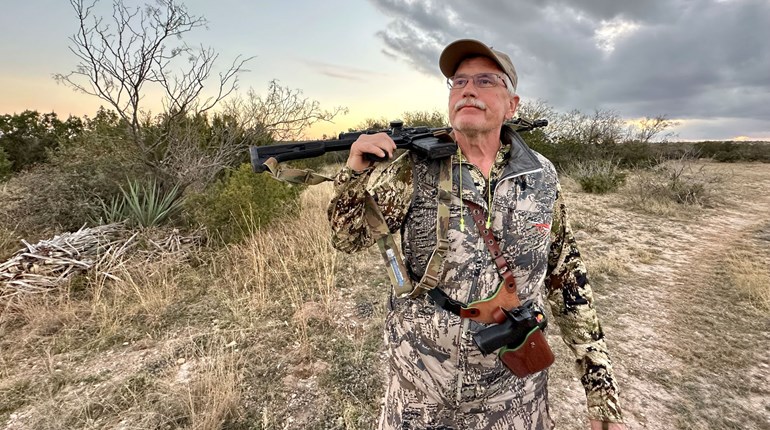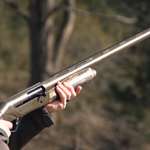Gray light was just beginning to wash over the Atlantic Ocean as our 21-foot boat, the “Quack Pearl,” pushed its nose out of the harbor and into the churning waters past the breakers. We headed south, staying a couple hundred yards from the rocky breakwater, looking for a likely spot to put out our sea duck decoys and then cast me onto the sea in the tiny layout boat. But it wasn’t looking good. I watched the gray-green waves slam against the huge boulders of the breakers, tossing foamy water high into the air.
“Had it near perfect the last two days,” said Capt. Brian Rhodes. “Today’s gonna be like sitting in a washing machine and trying to hit something with a shotgun. Choppy! We can stay in the boat?”
“No, I’ll do the layout,” I said.
“You’re the boss,” Rhodes said with one of his trademark wicked grins. “You took your seasick meds, right?”
The ocean swelled and lifted the boat, then dropped us down hard. It was much colder than it had been the last couple mornings, too—in the mid-30s with a stiff breeze. Hunting from the Pearl was the smarter option. But I’d done two mornings hunting sea ducks from the layout boat, and it would seem like, well, cheating to stay on the bigger, more stable boat.
Fifteen minutes later, I sat in the layout boat with three lines of Avery GHG sea duck series decoys strung out before me.
A layout boat? Laid flat, it’s about the dimensions of a queen-sized mattress. Made of fiberglass with metal hardware, a layout has tapered edges on all sides so the little vessel easily rides the waves. You sit in the center compartment, your legs and feet stretched out under the bow, and lay back, neck and head resting on a small backrest.
Dekes laid out on the ocean in front of you, the ducks come zooming in looking for breakfast, and you sit up and start shooting.
If you get a chance to shoot, that is. I wondered if pulling the trigger was going to happen that November morning as I rode up and down the roller coasters of green water. One second the decoys, just 25 yards in front of me, were visible. Then the layout dropped into a trough, the decoys disappeared, and four or five seconds later back up I went. On one of those upswings, I saw the first birds of the day, four eiders suddenly on me, swooshing over the water just yards away, so close I saw their eyes widen in surprise as they spotted me.
No time to even raise my shotgun. Damn! I hunkered down in the layout a bit further, fixing my eyes on the wave tops in search of the white-and-black eiders.
I had the distinct feeling the meds weren’t going to last all morning.
I was in Rhode Island, hunting sea ducks with Rhodes, 34, of The Swampers guide service, and Bryn Whitmier from Pennsylvania. Both men are pro-staffers with Avery Outdoors, a top manufacturer of all things waterfowl. When Avery invited me on a duck hunt, I asked about something different than layout blinds and puddle ducks. My contact suggested sea ducks on the Atlantic Ocean. In a layout boat, no less.
Along the East Coast, sea duck season is 100-plus days, from early October to late January. I got to Rhode Island right after Thanksgiving, flying into Providence, and met up with Rhodes and Whitmier. At dinner, we talked over the next morning’s hunt for eiders and common scoters.
“Let them get close,” Rhodes stressed. “Wait until they’re over your dekes, then you know they’re within 25 yards.”
“I can hit a little farther than 25 yards out,” I said, a bit offended, thinking my shooting skills were being questioned when I hadn’t even fired a shell.
“Sure you can.” Rhodes grinned, understanding that my hunting “feathers” were a bit ruffled. “But people are always surprised at how tough these birds are. You’re not killing an eider if you’re shooting it at 40 yards. Wait.”
The next morning, we joined the cluster of fishing boats making their way out to the open sea and headed south into Block Island Sound, hugging the shore. Sea ducks spend the night out on the ocean, Rhodes explained, sleeping together and forming large floating “rafts.” At daylight, they head inshore to feed.
Rhodes and Whitmier laid down three lines of decoys, weighted at both ends to keep them in place. They unstrapped the layout boat from the bow gunwales, and set it in the water. I climbed over the gunwale and into the layout. Whitmier handed me my shotgun, a box of shells and a two-way radio. They also dropped anchors off the layout’s fore and aft to keep it pointed toward the dekes. Rhodes moved his boat off a quarter-mile away.
Out there alone on the dark water, I felt the quiet. It’s a strange thing when a lack of sound becomes a force, a presence. I was tense, the whole experience too new for me to absorb all at once. But the weight of the quiet calmed me. I shifted back into the layout, scanned the horizon and the sky above. The sun was a red smear on the horizon when the first scoters came right over my face not 6 feet away.
Sea ducks come in low and fast, 3 or 4 feet off the water on a line. It’s not like mallards circling over a harvested soybean field and then sliding in. I shifted my line of sight to just over the layout’s prow, craning my neck. A pair of ducks zoomed in and I sat up, shotgun ready, too early, and they peeled off at 50 yards.
This happened a couple more times, and then I got it. What Rhodes had said: wait; close; be patient. It took three tries and maybe six shells before my first scoter hit the water. It flew in from right to left about midway into the decoys. I heard cheers from Rhodes and Whitmier echo over the water.
“Close” really did mean close; I needed to lay back until the ducks were at the edge of the dekes and fully committed. Angles? All different kinds can be had from a layout—and much sharper, tighter and lower. Plus, if I sat up in the boat too abruptly, the bottom shifted to one side, further throwing off my shot.
So it was on-the-job training on how to sit up, lift and swing my shotgun and fire, all of it as close as possible to one fluid move. It took practice, and a bunch of misses, but within an hour I bagged out, a young eider and four scooters, all drakes. I wasn’t real impressed with my shooting. There were four or five shells left in what had been a full box, but Rhodes was complimentary.
“Believe me,” he said, “I’ve had guys blast off two boxes of shells and have nothing to show except a sore shoulder.”
Sea duck hunting is just so unique, said Rhodes, in year nine as a sea duck guide. “I’ve had some really hardcore waterfowlers come out with me, guys who’ve killed every kind of puddle duck there is, pounded Canadas and snows for years, too. But they’ve never bagged an eider.”
“You want an eider,” Rhodes continued, “you have to come here, Massachusetts or Maine. And you have to get out on the ocean.”
The next morning the ocean was like glass again. But we only had a couple of flights and I barely managed a pair of scoters.
“It’ll be better tomorrow,” Rhodes promised as we headed back. “They’re calling for weather tomorrow. That usually gets them feeding hard.”
It was like hunting on a teeter-totter, up and down on those rolling gray waves. But the eiders—a lot of them—were on the move, veering out over the water at all sorts of crazy angles.
I took the first eider on a crossing shot right-to-left as he cut over the decoys. Several flights of three and four birds came right at my face and over me before I could react. Then a hen and drake seesawed in from my left, interested in the decoys and moving slowly. Two shots and I had the drake.
Nothing else showed for about a half hour and then several flights of eiders came over, and a handful of shots later, I had two more in the water. The limit was five, but no more than four of a species, so I’d have to wait for a scoter. “Or come back to the boat, let Whitmier shoot?” Rhodes asked over the radio.
I was done. My head hurt and my stomach felt like someone had punched me hard. Seasick meds had done all they could.
After Whitmier shot his limit of eiders, we pointed the boat toward the landing. I felt like I’d accomplished something, like I was a better hunter for the experience. Sure, I was a little seasick. That was a small price to pay for a morning on the ocean, though—that and the sun and the salt, the fast shooting, and eiders passing so near I could hear the wind whistle through their black and white feathers.





































